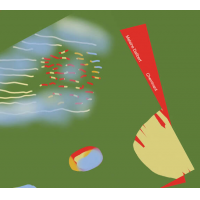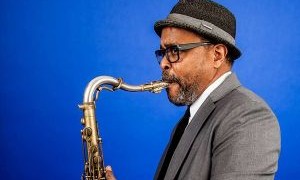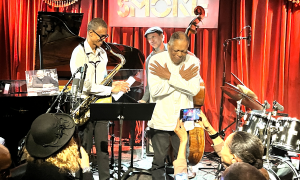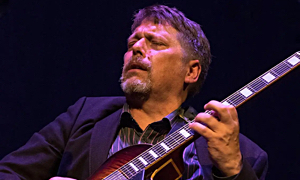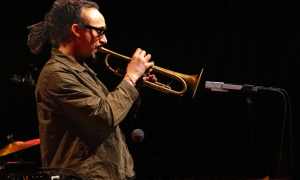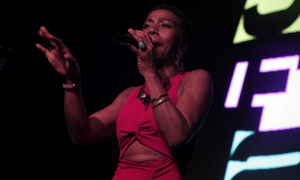Home » Jazz Articles » Live Review » A to JazZ Festival 2019
A to JazZ Festival 2019

We could charge forty Euros a day and have just a few hundred people here, or we can make it free and bring all these thousands of people in
—Peter Dimitrov, Artistic Director, A to JazZ Festival
South Park II
Sofia, Bulgaria
July 5-7, 2019
Jazz on a summer's day. There's nothing quite like it. To see Sofia's South Park II packed with somewhere between fifteen and twenty thousand people for three days of jazz, where a veritable sea of good vibes held sway, was an uplifting sight.
That people came in such numbers was chiefly due to the fact that A to JazZ Festival is a free festival. As festival founder and director Peter Dimitrov said: "We could charge forty Euros a day and have just a few hundred people here, or we can make it free and bring all these thousands of people in."
To be sure, not everyone who came to South Park II over the three days was there specifically to see Christian Scott aTunde Adjuah or Ghost-Note. It's quite possible, in fact, that many in attendance had never even heard of them. But that's not important. Just bringing people to the music, whether they know it or not; that is the point of A to JazZ Festival.
"There's a lost generation in Bulgaria," explained Dimitrov, referring to the children of the last decades of Communism, who grew up listening to the state-approved, national folk music of their parents' generation. "Ours is like a cause to bring them the world of music."
For the past eight years, A to JazZ Festival has done just that, with a roll call of artists including Christian McBride, Dianne Reeves, Roy Hargrove, Robert Glasper, Branford Marsalis, Kurt Elling, Michel Camilo and Jazzmeia Horn, to name but a handful of the A-listers who have graced the festival's main stage.
That American artists have dominated the programme should come as no surprise, given that the festival's main sponsor is the American Foundation for Bulgaria.
Since 2009, AFFB has supported Bulgaria's private sector and its democratic institutions, though American aid has been effective here since 1989 with the implementation of the Support for East European Democracy Act. In the aftermath of the collapse of Communism, SEED's aim has been to promote the transition to the free market and democracy. Significantly, this aid is not inter-governmental, but from private entity to private entity, therefore maximizing the power of donations.
In the case of A to JazZ Festival, the generosity of AFFB has ensured that Sofia enjoys the international prestige of a world-class jazz festival, while tens of thousands of Sofians' lives have been enriched by the music and the edifying experience of participating in such a joyous, communal gathering. And you can't put a price on that.
It's a far cry from the old days, when, according to Bulgarian jazz historian Vladimir Gadjev, writing in the Bulgarian chapter of A History of European Jazz: The Music, Musicians and Audience in Context (Equinox Publishing, 2018), no American jazz band visited Bulgaria between 1928 and 1978.
Nor is this exactly the sort of Cold War diplomacy typified by the famous Jazz Ambassadors programmes of the 1950s—1970s, but it does underline just how prescient war correspondent Burnet Hershey's words were, when he observed in 1922 that "jazz follows the flag."
AFFB, to its credit, has certainly left its mark and, even after just nine editions of A to JazZ Festival, a lasting legacy. There were no American flags flying in South Park II, but instead there stood some five hundred trees planted by the American aid programme. Between the trees, festival goers hung hammocks and rested in the shade, providing a beautiful metaphor of sorts.
And it was that kind of festival. Families with baby strollers pitched up. Groups of friends picnicked together. Children and tots were everywhere, running around or enjoying the music from the vantage point of a parent's shoulders. Daily outreach in the form of a Jazz for Kids programme sought to engage with the youngest children; stars perhaps, of future editions of A to JazZ?
There were dogs galore, chasing balls and sticks to their hearts content. A dedicated sports area offered humans an alternative to stick-chasing, with table tennis, badminton, volleyball and a mini-football pitch all seeing action. Frisbees cut graceful arcs through the warm summer air and bubbles were blown.
Czech beer, cocktails and Italian spritzers provided chilled relief from the hot sun. In the evening, as the light faded and the mountains were silhouetted against the blue-night sky, the multi-colored flashing neon lights of plastic gizmos dotted throughout the crowd created a scene like something from a Grateful Dead concert.
As dusk encroached, the music increasingly became a magnet for ever larger numbers of people, with a huge crowd captivated by third night headliner, Jacob Collier. The main stage also featured some of the best Bulgarian jazz musicians, exhibiting varying degrees of folkloric influence. For those with stamina, late-night jam sessions in Bar Caché, on the edge of the park, burned fiercely into the small hours.
Finally, a half-day conference—see separate article— -on day one set out to offer practical advice to Bulgarian musicians on how to equip themselves for a career in music.
Day One
JazzyBIT
It was a little bit of a thankless task for Romanian band JazzyBIT to open the festival 6:00pm, as there was only a small crowd gathered in front of the stage. Still, the audience showed its appreciation for the trio's upbeat, contemporary piano jazz. Bassist Mihai Modloveanu and drummer Szabo Csongor-Zsolt plied tight, funk and pop rhythms, while pianist Tendor Pop roamed more freely.Notable, were the GoGo Penguin-esque "Le Tunk" from Horizon (2016) and the Latin-infused show-stopper "Curacao" from the trio's debut album, Touch the Sky (2014). On the latter, Pop's tumbling piano lines gave way to a vamp, as his right hand worked the Nord organ keys feverishly. Imagine Michel Camilo reinventing Tito Puente's "Oye Como Va" and you might get some idea.
With its contagious energy, short but exciting solos, and hook-laden tunes, JazzyBIT was a sound choice for |A to JazZ 2019's opening act, taking the audience along with it for the ride.
Koka Mass Jazz
From Georgi Yanev's opening guitar riff it was clear that funk was the lingua franca of drummer Konstantin Katarsky's Koka Mass Jazz. Punchy melodic riffs from trumpeter Martin Tashev and saxophonist Dimitar Lyolev dovetailed with the soulful two-part vocals of Tiffani Blu and Krastina Kokorska, while keyboardist Milen Kukosharov brought swirling Hammond textures and bass groove.Energetic tunes from Elephunky Trip (Time Warp Music, 2018) kept the crowd moving and grooving, spiced by solo interventions from the excellent Yanev and the two horns. "Why" and "Getting Better" featured the tremendous rapping of Boyan Lechev, whose rhythmic drive was matched by his articulate delivery. Tiffani Blu and Yanev shone on the cooking blues-funk "Play The Game"; shimmering Hammond waves and sassy vocals colored the Chaca Khan-esque "Fight Fire With Fire."
Upbeat and feel-good throughout, Koka Mass Jazz paid homage to the Bulgarian capital on "Sofia's Street Light," with Tashev on fire. The uber-funky "Smile" got everybody clapping, while the band whipped up a collective storm on "By Myself" and the multi-layered, surging set-closer "No More." A terrific performance from a tight outfit that really kick-started |A to JazZ. The high-powered funk of Koka Mass Jazz would light up just about any festival stage.
Theodosii Spassov
Once described by the Chicago Tribune as like a cross between Ian Anderson and Thelonious Monk, Bulgarian kaval player Theodosii Spassov is revered throughout the Balkans—and far beyond—for his virtuosity. His collaborations, as varied as they are numerous, include Trilok Gurtu, Dave Liebman, Rabih Abou-Khalil and Billy Cobham. On the |A to JazZ stage, Spassov was reviving a folk-cum jazz project from a decade ago, his nine-piece band featuring an electric jazz quartet and a five-piece acoustic folk ensemble -the latter prominently featuring gadulka (an oud-like bowed instrument), gaida (bagpipes) and folk drums.From the get-go, Spassov's kaval, Peyo Peev's gaduka and Ivan Georgiev's gaida wove seamless unison lines, each in turn peeling off to solo. The juxtaposition of Nikolay Karageorgiev's electric guitar and Peev's gaduka soloing back to back was striking, but the most thrilling passages came when the nine-piece locked into frenetically charging unison lines.
Electric bassist Alexander Lekov and pianist Miroslav Turriyski led the way on a slower number, with the folksy refrain giving way to a multi-voice call and response of bluesy character. Folk melodies provided the canvas for Spassov's orchestrations, and despite the modern rhythms and fizzing virtuosity, the music sounded a little closer to Balkan folk traditions than to jazz. Whatever idiom the musicians traded in, both the solos and the intricately spun ensemble passages were thrillingly seductive.
At the head of the charge was Spassov, whose most fluid solos took wing spectacularly. In full flight, the kaval player sparked the crowd's enthusiasm and drew dizzying responses from the frontline trio of Peev, Georgiev and Karageorgiev. On one tune, an unaccompanied flute intro of haunting quality suggested a ballad, but the notion was dispelled by drummer Nacho Gospodinov, whose lively beat broke the reverie and ushered in a series of tearaway solos delivered at breakneck tempo. It proved to be the finale of an exhilrating concert.
Christian Scott aTunde Adjuah Quintet
The clue is in the name. The reclaiming of his ancestral (Benin) heritage lies at the heart of Christian Scott aTunde Adjuah's music—a wholehearted embrace of African American jazz tradition and contemporary influences. It reflects the philosophy of a man rooted historically, but with an eye very much on the here and now. This was a performance of passion and political resonance.The musical bridge spanning eras was potently sounded in the meeting of Corey Fonville's electronic drum-pad rhythms and Weedie Braimah's djembe on the pulsating opener, "I Own The Night." This was one of several compositions from Ancestral Recall (Ropeadope/Stretch Music, 2019) the leader's fourteenth album as leader/co-leader.
For his European tours these past few years, Scott aTunde Adjuah has turned to Polish bassist Max Mucha, a beautifully flexible player with impeccable timing and natural buoyancy. With long-standing pianist Lawrence Fields, and alto saxophonist Logan Richardson to boot, this was a powerhouse sextet and no mistake. Scott aTunde Adjuah lavished praise on Richardson, describing him as a game-changer on the alto saxophone, not so much for his technical facility as for his soulful sincerity, though both were evidenced during his solo on the uplifting "Songs She Never Sang."
There was post-bop fire on Herbie Hancock's "Eye of the Hurricane," with Fields, Scott aTunde Adjuah and Richardson trading breathlessly back and forth to loud cheers from the crowd. The loudest cheers, however, were reserved for Fonville's thunderous spot. The funky "West of the West" pitched horns together in piercing unison, though it was Field's ingenuity on organ, following the leader's own imperious solo, that arguably stole the show.
As powerful as the music was, many will come away with Scott aTunde Adjuah's words resonating in their minds. "We make a lot of noise about jazz being an American form of music," he told the crowd. "This is inaccurate. Jazz is an American form of music in so far as it is an extension of West African music." More thought-provoking still, was his extended extolling of the need for gender equality when it comes to pay. Given the platforms available to musicians, it's perhaps surprising that more don't take a leaf out of Scott aTunde Adjuah's book, and don the robes of socio-political influencer.
A fine set drew to a close with "The Last Chieftan," a rhythmically vibrant, melodically sharp tune that saw saxophone and trumpet weave mesmeric overlapping lines. The crowd coaxed the band back for an encore of Thelonious Monk's "Blue Monk." This slow-walking version, steeped in the blues, drew cheers from the crowd after each solo.
As thought-provoking as it was musically stirring, Scott atunde Adjuah's performance will long be remembered in Sofia.
Day Two
A to JazZ KIDS Program
On the second and third days of A to JazZ Festival, a shaded corner of South Park II was set aside for a kids' jazz program. A small , kid-sized stage, kid-sized drums, a keyboard and other assorted jazz instruments offered children of all ages the chance to make some festive noise. Several adult tutors encouraged the children, showing them simple rhythms, or for the youngest, simply how to hold an instrument and conjure any sound. Their sound. The atmosphere was super-relaxed and the parents seemed delighted with the set-up.A to JazZ Festival is a kid and family-friendly festival in more ways than one. On a couple of occasions, between songs, gigs were briefly interrupted to announce a lost child, separated from its parents. People come to A to JazZ Festival knowing that the environment is a safe one and that everybody's well-being is of primary concern to the festival organizers. Musicians too, were appreciative of this caring philosophy, where even the music comes second to reuniting a stray child with its parents, or stray parents with their child.
It is possible, too, that A to JazZ Festival is the cleanest outdoors jazz festival on the planet. At any time during the day, and even at the end of each day with the crowd dispersing fairly quickly, there was barely a trace of litter to be seen anywhere in the park. The company responsible for policing the litter, Antilopa Cleaning Services, did a marvellous job. Every festival in the world should have an Antilopa to keep the shared spaces clean, green and safe.
The spotless environment in which A to JazZ Festival was held contributed much to the relaxed atmosphere. It was possible to throw down a picnic rug, or simply stretch out, absolutely everywhere.
National Music Academy Big Band
Making its second appearance at A to JazZ Festival, the National Music Academy Big Band, a rousing twenty-piece ensemble led by trumpeter/composer Mihail Yossilov got the second day off to a cracking start. A swinging, Count Basie-esque blues number kicked things off, with guitar and alto saxophone to the fore. Vocal numbers from the standards book dominated, with the lush harmonies of Trinity Trio (Slavina Kalkandzhieva, Bozhana Spasova and Miglena Ruseva) on Natalie Cole's sunny "This Will Be" the pick of the bunch. Having risen to national prominence on a national TV talent show, Trinity Trio boasts the sort of star quality that could take it far.The big band really came into its own on the set's few instrumentals, the collective swagger matched by fine solos on the Gershwins' "Fascinating Rhythm" and the grooving "Hip-Hop-Tropa"—the latter by renowned Bulgarian jazz drummer/composer Hristo Yostov. The Tower of Power's "Digging on James Brown," sung with gusto by Christian Grancharov, and Aretha Franklin's "Think," featuring the wonderful Trinity Trio once more, took the National Music Academy Big Band out on a high.
Dimitar Bodurov
One of Bulgaria's most revered jazz musicians, Amsterdam-based pianist/composer Dimitar Bodurov has gigged and recorded in a variety of settings, from solo piano to collaborations with Theodossi Spassov, Sandip Bhattacharya, Randy Brecker, Didier Lockwood and Michael Moore - Clarinet. This concert, however, featured Bodurov's main vehicle since 2004, a trio with bassist Mihail Ivanov and drummer Jens Dueppe.This was an all-acoustic outing, though Bodurov's laptop conjured the choral intro to "Penyo Penyo," a striking track from the pianist's Stamp Around (Optomusic, 2015).The choral refrain provided the rhythmic framework for the trio's explorations. Over probing rhythms, Bodurov fashioned an exciting, rhythmically charged solo that revealed his hybrid jazz/classical background. There are more colors to Bodurov's pallete, however, as the baroque-cum-folkloric voicings of "Mamo" elegantly demonstrated.
The folk music of Bulgaria has long informed Bodurov, and his deconstructions of time-honoured tunes on the A to JazZ stage foregrounded melody, while using the same for explorations in rhythm and tempi. In a sense, Bodurov mines similar folkloric terrain to that of France-based, Serbian pianist Bojan Z, and if there were occasional similarities in Bodurov's vocabulary, it is perhaps due simply to the porousness of borders and the fluid, trans-national nature of culture.
Bodurov Trio might be better appreciated in a club environment or concert hall, as the constant chatter and banter of the festival crowd detracted to some degree from the trio's more nuanced interplay, particularly on a gorgeous, keening ballad, complete with pre-recorded vocals. The trio signed off with a flourish on a rhythmically dynamic number characterized by a cantering groove.
An engrossing performance from a pianist, and a trio, deserving of wider attention.
Preyah
Her star having risen via X Factor Bulgaria, Sofia singer Preyah has become one of Bulgaria's best-known pop stars. And this with her debut album still to see the light of day. Backed by bass, guitar, drums, saxophone, trombone, synthesizer and percussion, Preyah's sound was organic yet contemporary, and above all else, soulful.Denis Popstoev's synthesizer was prominent throughout, but Preyah's music followed no obvious pop roadmap. R&B in essence, her voice lay somewhere between Tina Turner and Macy Gray. These were well crafted, radio-friendly compositions full of spirit, though perhaps just a little too one-paced, in the main. The South Park II crowd wasn't complaining, however, and gave the talented singer a loud send-off.
Ghost-Note
A party is the best way to close any festival night, and Ghost-Note certainly rocked the huge crowd with its high-energy, funk-fuelled jazz. This off-shoot of Snarky Puppy was founded by drummer Robert Sput Searight and percussionist Nate Werth, and draws in equal measure from James Brown, George Clinton, J-Dilla, Afrobeat, hip-hop, and jazz -a truly potent brew.Looking like he meant business with his yellow hard-hat, Searight drove the seven-piece band with uncommon intensity, with rhythm partner, bassist Dwayne "MoonNeon" Thomas, playing deep, booty-shaking grooves. A three-pronged front line of alto saxophonist Jonathon Mones, tenor saxophonist Mike Jelani Brook—both doubling on flute— and guitarist Peter Knusden, all unleased bolts of lightning over the rhythmic storm brewing beneath.
The set drew from Fortified (RSVP, 2015,)-from which the slow grooving, flute-colored "Joshua Johnson" provided a set highlight—and the roof-raising double album, Swagism (RSVP, 2018). But in truth, Ghost-Note could easily have jammed on one its infectious grooves, say "Milkshake," for the whole ninety minutes, Fela Kuti style, and the crowd would have lapped it up.
There was tribute to djembe player Weedie Braimah—who lit up the stage the night before with Christian Scott aTunde Adjuah—on "Weedie B. Goode," a slow- burning, funk workout crowned by Knudsen's smoking guitar solo, and an equally fiery improvisation from keyboardist Vaughan Henry. The ballad "Fragile," with its soft flute melody, brought a change in atmosphere, but like moths drawn to flame, Ghost-Note were soon chasing the funk grooves once more, saluting the crowd with yet another heady adrenaline rush.
Huge cheers and applause acknowledged a mighty performance from the world's premier funk dealers.
Jam Sessions
One of the unforgettable aspects of A to JazZ Festival was the nightly jam session held in Bar Caché, a hip venue with open-air area, conveniently located on a corner of South Park II. Bar Caché was a magnet for late-night revelers, hundreds of whom gathered outside on the grass where they continued to party, with the jam sessions raging just metres away.And what sessions they were! Local musicians, both amateur and professional were of a uniformly high standard and there was a seemingly never-ending stream of them. They shared the bar's small stage with many of the stars who had performed on the main stage. Few who were there will forget witnessing the guys from Ghost-Note jamming on John Coltrane with the locals.
Drummer Robert Sput Searight took the piano stool and played like Don Pullen. At one time he comped for a good thirty minutes behind the soloists, never settling on a vamp for more than a few seconds, and never coasting. His constant invention as an accompanist, and his rhythmic power, were something to behold. The special atmosphere of the Bar Caché jam sessions had much to do with the close proximity of the crowd to the musicians, which created a heady, cauldron-like atmosphere.
Another special moment came the same evening when trumpeter Mihail Yossifov and pianist Angel Zaberski rendered homage to João Gilberto, who had died earlier in the day. Their version of "The Girl from Ipanema," played as a lament, was magical.
Plenty of jazz singers took to the stage. Trinity Trio, with stellar backing, gave a brilliant performance of "Sing Sing Sing." Improvising vocalists really cut loose, afforded just as much space as the instrumentalists. Of note was twenty-five-year old singer Simeon Zhelyazkov, a rather special talent, with a real feel for the music.
The excitement generated at these jam sessions was palpable, with the crowd inside and outside the bar cheering and whooping after each solo. Ulrich Beckerhoff, who has seen and participated in more than a few jam sessions during his illustrious, fifty-plus-year career, was prompted to comment: "I can't remember seeing a jam session like this for many years."
Day Three
The final day of A to JazZ Festival 2019 got underway with Dimitar Karamfilov's Ecology. The bassist/composer has collaborated with Bulgaria's finest jazz musicians in Milcho Leviev, Jivko Petrov Trio BG and Theodsii Spassov, but is making a name as a leader in his own right with the release of his debut album Ecology (2018).Karamfilov's driving bass was the heartbeat of the quintet, with pianist Konstantin Kostov, drummer Hristo Yostov and guitarist Alexander Logozarov making up the lithe rhythm section. Trumpeter Mihail Iosifov and Spanish saxophonist Arnau Garrofé Farràs led the attack with snaking solos on post-bop fare, the music lent a contemporary edge by Logozarov's biting, rock-edge improvisations.
The music was Karamfilov's response to environmental degradation, and the energy and thrust of the music seemed to reflect the urgent need for a revaluation of our relationship with nature. The band was joined by vocalist Marina Gospodinova on "Bathe Me in Your Dew"; her caressing delivery of this Bulgarian folk song, delicately jazzed up, brought a beautiful change of tempo and mood.
Gospodinova's spoken-word delivery coursed through the set's standout track, "Produced Nature." Here, restless rhythms, edgy piano, pedal-altered guitar effects and burrowing tenor saxophone underlined the gravitas in the song's ecological warning. Solo after solo ratcheted up the tension before this epic number resolved in a harmonious, though accelerated finale.
Dimitar Karamfilov's Ecology was rewarded with a prolonged ovation. Engaging music interpreted with panache-this is a band we're likely to hear more of in the future.
MEY feat. JCAT
You could almost tell from the name that MEY feat. JCAT would veer more towards pop than jazz, and though that was indeed the case, the band's seductive vibe won over the crowd. Formed in 2015 by French bassist Thomas Cordogli and Bulgarian singer Magi Aleskieva—and featuring pianist Jean-Charles Battistella and drummer Alexandre Gauthier— MEY feat. JCAT has released three albums, with the bulk of its set taken from Love and Receive (2018).The gently breezy "Spring Time" set the tone for much of the set, though Battistella's more jazz-inflected language provided a foil to Alexieva MEY's sultry, Neo-soul vocal on "Never Talking." Flashes of jazz improvisation enlivened the panorama, but for the most part the music was laid back, as on "Vocalise," a wordless vocal number of gently haunting qualities. The occasional instrumental trio passages were more firmly jazz-oriented, with Cordogli unleashing one spectacular bass solo on the set's animated closing number.
With its artfully conceived hybrid of pop, soul and jazz smoothly delivered, MEY feat. JCAT has fashioned an original identity that should ensure broad appeal. Maybe not something for the more serious jazz heads, but likely to satisfy many open-minded music lovers.
Ritmos Negros
Fresh from a successful performance at Glastonbury, Ritmos Negros raised the temperature with a lively set of songs based on Afro- Peruvian song. The driving force of Ritmos Negros is singer/cajon player Piero Epifania, but if traditional/popular songs and rhythms are his main inspiration, then his quartet featuring electric bassist Boris Taslev, acoustic guitarist Simeon Leonidov and saxophonist Arnau Garrofé Farràs brought a vaguely jazz-flamenco flavor to proceedings.Sung in Spanish, Epifania and Ritmos Negros interpreted songs by Pepe Vasquez, Andres Soto and Wilfredo Franco Laguna—renowned twentieth-century Peruvian composer/singers all. On Soto's "Negra Presuntuosa" there were echoes of Cuba's Vieja Trova Santiaguera, while on Augusto Polo Campos' "Regresa"—made famous by Lucha Reyes —-Leonidov dealt sparkling arpeggios and a bluesy flamenco air.
An instrumental number allowed each musician to stretch out— with Garrofé Farràs particularly impressive. The versatile saxophonist, who had impressed earlier in the day in Dimitar Karamfilov's Ecology, switched to flute on "No Valentin," bringing a vein of sweet lyricism to Pepe Vasquez' song.
At the heart of the music, however, was Epifania, whose vibrato-less delivery was more rock 'n' roll than the lyrical interpretive style of Reyes or Susana Bacha, artists more usually associated with these songs. Epifania's own compositions, such as "Cruzando La Frontera" and the beautiful "Sandia y Flores," sat comfortably alongside the classics of the Afro-Peruvian traditional repertoire.
The concert whizzed by in a flash and earned Ritmos Negros one of the loudest ovations of the weekend. It would take no great leap of the imagination to see Ritmos Negros winning over audiences at Spanish jazz or flamenco festivals. Or indeed any international festival. A terrific festival band, no doubt, but you can bet that Ritmos Negros' stirring take on Afro-Peruvian songs would sound even more powerful in an intimate club setting. A band to watch out for.
Jacob Collier
By now Jacob Collier is not so much the hottest new thing as an established, major star on the festival circuit. Still, his is a remarkable story— the ultimate Youtuber success story. The roars that greeted him as he bounded onto the A to JazZ Festival stage in Sofia are replicated pretty much everywhere he plays. Feted by Quincy Jones and Herbie Hancock, Collier, it seems, can call on any musician and they come a-running.Arguably the most famous, and probably the most visible multi-instrumentalist on the planet, Collier is also hugely ambitious, musically speaking. This concert showcased some of the music from his Djesse project—four albums in one year, comprising forty songs, and covering pretty much every style of music. So, no surprise then, that he led his slick quartet through a dizzying array of genres, with the common denominator, perhaps, his signature harmonics.
Bounding onto the stage to a striking light show, Collier led the crowd in an old-fashioned call-and-response. It was something he returned to time and again, and, if truth be told, the gimmick overstayed its welcome at times. Whilst it was easy to marvel at the reach of Collier's vocal range, his voice is an acquired taste. Impressive though, his musical athleticism, leaping from piano to keyboards, from keyboards to percussion, from percussion to stand-up bass, from bass to guitar, and singing all the way. There was nothing, it seemed, that he could not do.
Robin Mullarkey and Maro also fielded a wide range of instruments, the former mostly handling those of the stringed variety, the latter on keys and vocal harmonies throughout. The multifaceted Maro is something of a special talent herself, as her beguiling solo rendition of "Mariana" demonstrated. A little more spotlight on the talented Portuguese artist and a little less of Collier's uninspiring call-and-response sessions with the crowd might have made for a stronger set.
Playing just the one instrument, drummer Christian Euman was, in his own way, the most impressive musician on display. His grooves were powerful, his timing impeccable. He really drove the music. It was no coincidence that Collier's most arresting arrangements featured the Chicago drummer at his most expansive.
With so much musical language at his disposal, Collier's dilemma seemed to be where to place his energies. His piano playing was fleetingly impressive—he studied jazz piano at London's Royal Academy of Music—and his harmonization in general was captivating. And yet, the songs, for all their complexity, were somehow less than the sum of their multiple parts.
It was Collier's breathless showmanship, and his fluid musical style that stayed etched in the memory, as opposed to individual tunes. Collier's reharmonized arrangement of "Danny Boy" seduced, but a bland version of Lionel Ritchie's "All Night Long" failed to take off. The encore solo piece, The Beatles' "Blackbird," was hijacked by another extended call-and-response, which the crowd latched onto with glee, but it made for something of an anti-climax.
Throughout the concert Collier held the Sofia crowd in the palm of his hand. The crowd, thousands strong, took the multi-talented Collier to its heart.
Wrap-up
Almost as memorable as the music itself at A to JazZ Festival 2019—and between the main stage and the incredible jam sessions there was certainly plenty to get excited about— was the cheery atmosphere in which the festival unfolded. No wonder that people turned up in their thousands, for the beautiful location, the relaxed, holiday atmosphere and the friendly vibe of everyone working at the festival site made for the perfect backdrop to the music.That the music was free to the public was, of course, the main reason for such large crowds. The America for Bulgaria Association clearly see the cultural value in supporting A to JazZ Festival, and it is to be hoped that the Sofia Municipal Council continues to share its long-term vision.
Whilst it's impossible to quantify the benefits of exposure to such high-quality jazz/related music, it's a safe bet that the effects are nothing but positive. An international festival of the calibre of A to JazZ Festival contributes much to the luster of Sofia's cultural calendar. More concretely, the jam sessions in Bar Caché must have been utterly inspiring to the Bulgarian jazz musicians who shared the stage—and held their own—with world class musicians, roared on by hugely appreciative and encouraging crowds.
The jazz program for kids is a worthwhile grassroots initiative that recognizes the importance of bringing music, and more precisely creativity, into people's lives at a very early age. The presence of so many kids at this family-friendly festival helps ensures a public for this sort of music in the years ahead—and not just during the dates of A to JazZ Festival, but whenever great music is performed in Sofia.
Likewise, the A to JazZ Talks clearly demonstrated that they have the capacity to motivate, inspire and to direct young Bulgarian musicians who aspire to a professional career in music, whether jazz or another genre altogether. It is to be hoped that the A to JazZ Talks will become a pillar of the festival for many years to come.
In 2020, A to JazZ Festival celebrates its first ten years. Big crowds are once again expected for what promises to be a tremendous celebration of this music, African- American in origin, that is now, as it enters its second century, truly a citizen of the world.
Photos: Courtesy of A to JazZ
Tags
About Christian Scott aTunde Adjuah
Instrument: Trumpet
PREVIOUS / NEXT
Support All About Jazz
 All About Jazz has been a pillar of jazz since 1995, championing it as an art form and, more importantly, supporting the musicians who make it. Our enduring commitment has made "AAJ" one of the most culturally important websites of its kind, read by hundreds of thousands of fans, musicians and industry figures every month.
All About Jazz has been a pillar of jazz since 1995, championing it as an art form and, more importantly, supporting the musicians who make it. Our enduring commitment has made "AAJ" one of the most culturally important websites of its kind, read by hundreds of thousands of fans, musicians and industry figures every month.



